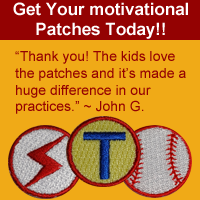Hitting - Stride
Introduction
Some hitters will not have a traditional stride and there is nothing wrong with that as long as they can pause in some way to adjust for different types of pitches. For youth players I do believe it's good to teach them a standard stride but I wouldn't force kids who have a leg kig or toe tap to change.
A common mistakes made by hitters is having the stride be part of the swing. What I mean by that is that for many hitters when they begin their stride, they have committed their timing at that point and once the stride foot hits, they swing the bat. This makes it very difficult to adjust to the different types of pitches you're going to face.
Striding while keeping your weight back allows you to hold that position and adjust for the different speeds and locations of the pitch. That ability to hold that position for a split second without having your weight continue forward is critical in being able to adjust to different pitch speeds and locations while keeping bat speed and power.
1. Make sure you don't get your weight too far back when you've completed the coil. It may seem easy to stride softly but it will cause problems when you go to swing.
2. If you allow your weight to drift forward to your front foot during the stride, you'll have a difficult time holding that position and adjusting. It will cause problems with your timing and your ability to hit the ball hard.
3. Avoid excessive hand movement during the stride. The more your hands move the greater the opportunity to have them in the wrong position at the conclusion of the stride.
Overstriding
Stride length: A common trend in the major leagues is to have very little stride. As more players use a more rotational swing, they realize that a long stride is counterproductive when it comes to having a compact swing. Let's think about what we want to happen in the stride. We want our weight to stay back and have just a little come forward with the stride in order to maintain good balance. We want to make sure that our timing is perfect and our front foot touches down in time and we're ready to swing at that point. We want to keep our head as still as possible in order to make it easy to track the ball. All of these items that we want to accomplish are made more difficult by having a long stride. If you have a long stride, more than 4 or 5 inches (less if you aren't fully grown), this is the time to correct it.
Overstriding can be caused by two things.
1. Your feet are too close together in the stance. If your feet are shoulder width apart or less, simply adjust your stance a little wider and step to the same spot you did before.
2. Your stance is fine, but you think a big stride will help you get more weight behind the ball and help you hit it harder. In fact, the large stride is causing you a loss of timing and a loss of power.
In both cases you have developed a habit of striding too far and overstriding can be a difficult habit to break. It takes time and repetition to build the new habit of striding correctly and having the proper length.
How to correct overstriding: Although the habit can be difficult to break, the correction for overstriding is rather simple. Whenever you are swinging a bat, place either another bat, piece of wood, or something else in front of your stride foot between 4 to 6 inches away when you get in your stance. As you take your stride and your swing, you then want to make sure your foot lands behind the object you placed. Over time this will build the new habit of striding the proper distance. You cannot correct this problem in a day or two. Keep placing that object in front of your foot until you no longer have to think about it even being there.
Timing
When I work with young hitters I find that most of them don't realize the importance of the coil and the stride in relation to timing the pitch. Too often the player thinks that the stride should be made after they have determined that they need to swing, or they take their stride without adjusting to the different speed of a particular pitcher. The start of the coil must be adjusted slightly to the speed of each pitcher. We don't want to rush those movements or we will negatively affect our swing.
Starting your coil at the right time and having that movement and the stride be smooth and consistent are important factors in being able to correctly time the pitcher. This should be done from the on deck circle before every at bat so you know when to begin your stride to be ready for that pitchers best fastball.
1. Stride softly keeping most of your weight back.
2. Make sure you are balanced after your stride foot lands.
While keeping your weight back, make sure you feel the weight on the inside of your back leg, not the outside. A good way to feel this is to make sure that you can feel your weight on the inside part of your back foot (the ball of your foot).
2. Timing! Timing! Timing! Your coil and stride need to be timed for the inside fastball. A common problem for many hitters is having their stride foot land too late. You will always be behind on a good fastball pitcher if you allow this to happen.
Activity
Get in your stance and take a few strides and swings. Have a parent place a stick or something else at the front of the stride foot. Then take your stride and stop and have a parent place another stick or something at the front of the stride foot. Now measure the distance of your stride. If your stride is too long you'll want to work on correcting this using the method above before you start working through the other aspects of this lesson. You need to practice your stride by taking it with the correct length!
Once you have the correct length, work on taking your stride and pay close attention to keeping your weight back and having the majority of your weight on the inside of your back leg.
Finally, check the position of your bat when you've completed your stride. It should be at a good angle and slightly off your back shoulder. You need to be ready to swing at this time, so your bat needs to be in the correct position. Have a parent watch your stride and let you know where your hands are when your front foot touches down. If your hands aren't slightly off the back shoulder at that time then you most likely have developed a hitch and you'll need to correct that problem.
Most Recent Blog Posts
Working With Players on Focusing on the Correct Part of the Baseball when Hitting (October 15 2016)
Getting More Accurate Throws From Your Team (April 5 2016)
I simply want to thank you for starting this site. I love the experiences you have shared and they really hit home to me. Please keep up the great work.
- Jeremy C.







